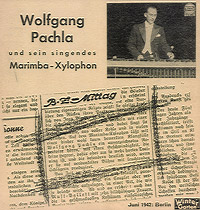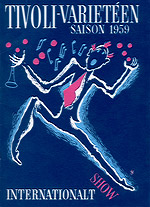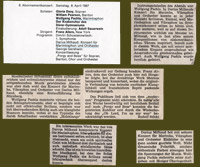The Press and Tributes
Tallinn, Estonia 1938 /1939translated from Estonian..
Wolfgang Pachla, the man who made "bone talk" for 10 years on the radio.
One used to call the Xylophone "bone talk" because of its unique sound. Many composers such as Saint-Saens used the Xylophone in his "death-dance" to characterize the dancing of skeletons. In Germany the Xylophone is also known as "wooden laughter".
In an evening public radio broadcast, the audience has not only the opportunity to hear but also to see Wolfgang Pachla. Because we have not had such a radio broadcast for a long time, we hope that we will have a good audience.
The soloist Wolfgang Pachla will be performing solo Xylophone at 8:40 pm.
The only musician of his kind in Estonia
On Monday the Radio will be celebrating the 10th anniversary of Wolfgang Pachla's performances.
His name is often associated with public radio evenings and colourful New Year's Eve programs. To put it in a nutshell, when something is "on" then Wolfgang Pachla is there with his exotic instrument.
Xylo-Marimba is the technical name for this, by its sheer dimension, awe-inspiring instrument, whose price is just as awe-inspiring: this wonderful instrument with spokes and silver cylinders weighing 150 kilos costs 1800 Crowns.
Our listeners remember that Wolfgang Pachla up until now has performed on the Xylophone. The interesting question for us is just what is the difference between a Xylophone and a Xylo-Marimba. Whereas the earlier instrument's range was 2 octaves, the Xylo-Marimba can easily be played over 5 octaves. Wolfgang Pachla purchased the instrument in England and has been playing it for 11 months.
"The general opinion is that the Xylophone represents some kind of circus instrument. I am endeavouring to prove and to show that serious music with all their subtleties such as the Chopin Etudes, Sarasates Zigeunerweisen and similar works can all be performed very well on the Xylo-Marimba", said Wolfgang Pachla.
"How old were you when you began to play this instrument?"
"I was six years old. My first teacher was my father. I was so small at that time that my nose only just reached the edge of the Xylophone".
Wolfgang Pachla practices 3 hours a day. He also studied at the conservatorium, but actually in the violin class. As there was no Xylo-Marimba class at the conservatorium, he taught himself on the instrument.
Last year he performed at the Radio stations in Helsinki, Stockholm and Riga. There are comparatively few Marimba soloists, as the instrument is usually used as percussion in the orchestra.
W.Pachlas Concert
October 1st. 1939 in Viljandi (Fellin)
On Sunday October 1st the Xylophone virtuoso Wolfgang Pachla performed in the Koidu Hall and presented his unique percussion instrument the Xylo-Marimba to the people from Fellin for the first time. The first piece performed, Liszt's 2nd Rhapsody, was already enough to convince us that Wolfgang Pachla is undoubtedly one of the most superb masters in his area.
We were able to tell that the Marimba is a very melodic instrument during Chopin's c minor Waltz and Lemba's "Song without words". The wooden sound, with which the simple Xylophone is labelled, disappeared leaving a singing melody in its place.
The artist included enough melodic works and was able to prove that the Marimba can be a concert instrument.
The opening piece was a virtuosic piano piece, whereas the concluding work was from the violin repertoire: Sarasate's Zigeunerweisen with which the soloist was able to gain recognition and fascination for his exceptionally virtuosic performance.
His wife Lia Pachla-Steinberg accompanied him on the piano, and also performed 3 solo works by Mozart, Liszt and Chopin. They were impressively performed suiting their respective characters.
Germany 1942:
"BZ am Mittag" June 1942 about the Wintergarten Program:
With an unprecedented monumental sound production on the Marimba-Xylophone Wolfgang Pachla lets us hear an excellent repertoire in a tempo that is not witchcraft, but hard training. The darkened stage and fluorescent mallets enhanced the fast tempo.
Another newspaper from Berlin:
The Marimba virtuoso Wolfgang Pachla went beyond an everyday achievement. He is one of the most applauded artists at the Radio Station. His magnificently polished technique lets the wooden Xylophone sound disappear, and be replaced by a singing melody that brings an astounding fullness in performance.
Denmark 1959 (Wolfgang Pachla's. performances at the Tivoli-Varieté)
"Berlingske Tidende" Copenhagen (July 3rd.1959)
"----- And the musical impact of the evening, in the best sense, the literal meaning of the words, was given by a performance by the Marimba virtuoso Wolfgang Pachla. -----"
An additional daily newspaper from Copenhagen on July 3rd 1959:
"The Estonian Marimba virtuoso Wolfgang Pachla plays his instrument so rapidly that he really earns the virtuoso title"
Nuremberg 1967
Abonnement concert series on April 8th and 9th in the Meistersingerhalle Nuremberg
Nürnberger Nachrichten (Nuremberg news):
The expressive peak of this enlightening and fortunately exclusively contemporary music evening was the concerto for Marimba, Vibraphone and orchestra from Darius Milhaud, which was also a Première for Nuremberg. Wolfgang Pachla mastered both percussion instruments in a virtuosic way, not satisfying himself with brilliant effects, but with nuances of sounds achieving surprising success. He was impressively able to utilize the typically amplified wooden sound of the Xylophone that is achieved by the resonance chambers. Franz Allers, to whom the orchestra followed devotedly, offered the 3-movement work transparency, whereby the original connection to almost exotic sound and French esprit made an enthralling impact.
Nuremberg Newspaper:
The instrumental soloist of the evening was Wolfgang Pachla. He made a brilliant impression in Milhaud's concerto for Marimba, Vibraphone and Orchestra. First of all it is very seldom to hear Marimba and Vibraphone in an orchestral concert, and secondly because he is a true master. Milhaud's composition is gripping and with its playful elegance inspires both the unsophisticated and the sophisticated listener. As with many other pieces of this composer, the inspiration came from South American dances. Wolfgang Pachla was heartily received.
Fränkische Tagespost:
The concerto composed by Darius Milhaud for Marimba, Vibraphone and Orchestra is a very interesting work. It is seldom that solistic pieces are written for these instruments, and it is surprising that such a spiritual soul such as Milhaud wrote 3 rhythmical and melodically intricate movements. The soloist Wolfgang Pachla was able to exploit his convincing technical percussion skills in an unprecedented exciting musical game.
Abendzeitung:
Darius Milhaud was able to offer glimpses of another different world in his concerto for Marimba, Vibraphone and Orchestra. It was the orchestral timbres and not the dynamic polarity that produced the tension in the music. Wolfgang Pachla mastered his task with relaxed superiority.
In 1979, to celebrate Wolfgang Pachla's 60 years as a performing musician,
the Bayerische Rundfunk (Bavarian Radio) broadcast an elaborate radio program with a live interview with him. Kurt Illing made new arrangements of a number of Wolfgang Pachla's bravura pieces for large symphony orchestra and recorded them with him.
Posthumous Tributes
Bent Lyloff published in the Danish percussion magazine "Slagkraft" in October 1986
There were various articles in 3 different magazines in August 1993 in Tallinn (Estonia) that were compiled by Avo Hirvesoo along with a radio broadcast for Wolfgang Pachla's 80th birthday:
In "Musikblatt" August 93 No. 11/12, in the culture magazine "Sirp" 13.8.9 3, and in "Järva Teataja" No. 104/105.
As a homage to his 25th anniversary of death,
an article was published in a magazine for Estonian people living in Germany:
"Eesti Rada" November 2007 and a Portrait was transmitted by the Estonian Radio Station "Eesti Raadio".







